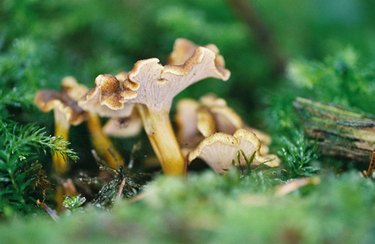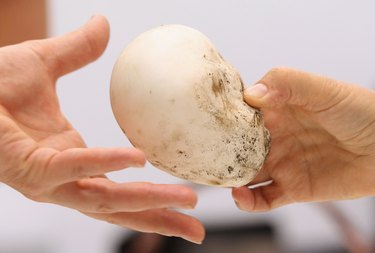
Ohio is home to more than 2,000 varieties of wild mushrooms, according to The Ohio State University. While some are edible and others are poisonous, it is unknown whether it is safe to eat the majority of these species. Mushrooms grow in a variety of terrain in Ohio where there are plenty to keep any mushroom hunter happy.
Chanterelle
Video of the Day
One of the most prized edible mushrooms that grows in Ohio is the chanterelle. Also known as Cantharellus cibarius, this medium-sized mushroom is either yellow or orange in color. Chanterelles do not have gills, like many other mushrooms, but folds and ridges on its top. According to The Ohio State University, they most commonly grow from June to September in the shade of oak trees. Novice mushroom hunters should take care when harvesting chanterelles, especially since they look the poisonous jack-o-lantern mushroom.
Video of the Day
Giant Puffball

The giant puffball is an easily recognizable mushroom that grows in Ohio. Also known as the Calvatia gigantea, these giant mushrooms are extremely tasty and typically are found in late August through October. The giant puffball, which is typically white, gets its name for its appearance: a giant white ball that can grow in diameter from eight to 24 inches, according to the Ohio State University. Giant puffballs like to grow in open areas such as parks, meadows, pastures and even in some urban areas.
Destroying Angel
The destroying angel is a very poisonous mushroom that grows in Ohio. Also known as the Amanita bisporigera, the destroying angel has long white shafts with a rounded smooth cap. They typically are seen from July to October and grow in the woods. According to the Cornell Mushroom blog, the destroying angel is damaging to the liver and a large majority of people who eat them do not survive. If you accidentally eat a destroying angel mushroom, it is imperative you call poison control immediately and see a doctor.